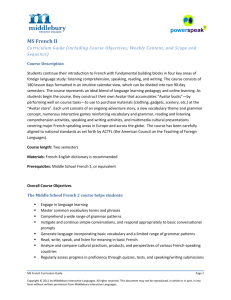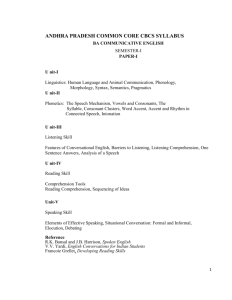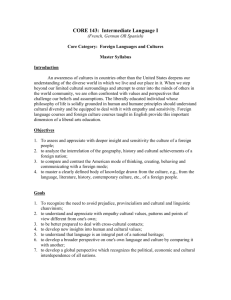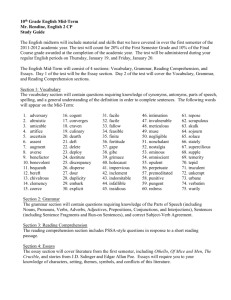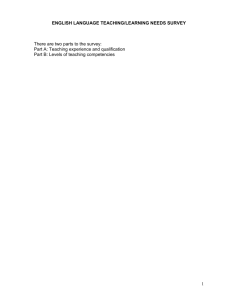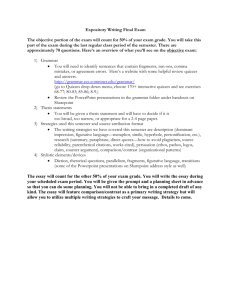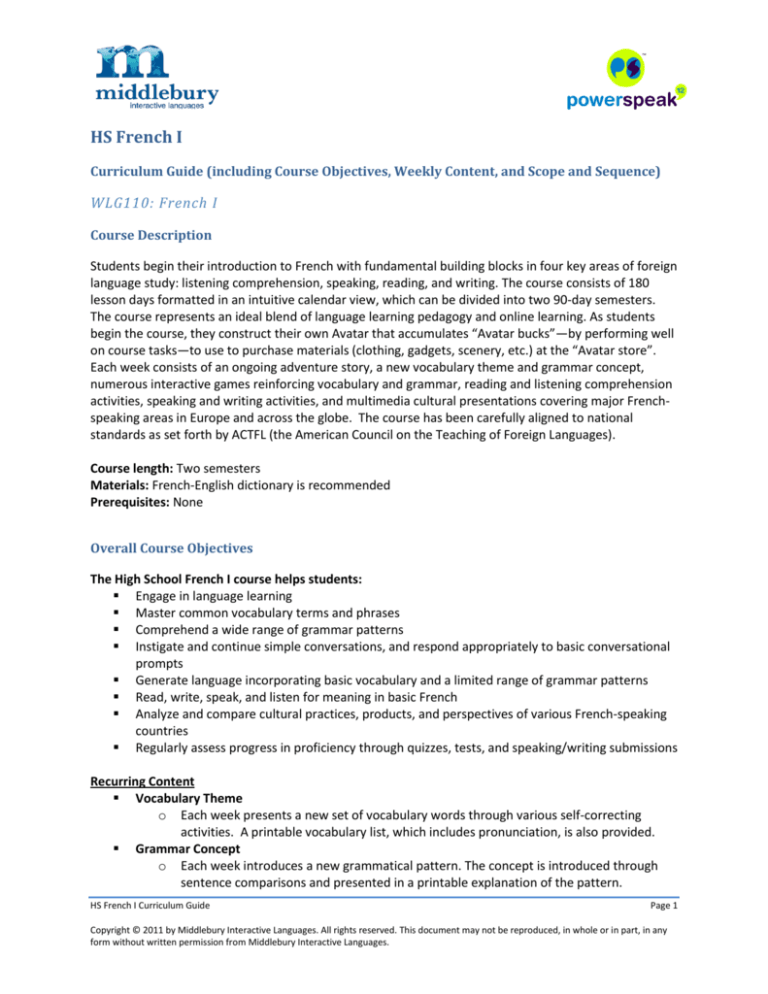
HS French I
Curriculum Guide (including Course Objectives, Weekly Content, and Scope and Sequence)
WLG110: French I
Course Description
Students begin their introduction to French with fundamental building blocks in four key areas of foreign
language study: listening comprehension, speaking, reading, and writing. The course consists of 180
lesson days formatted in an intuitive calendar view, which can be divided into two 90-day semesters.
The course represents an ideal blend of language learning pedagogy and online learning. As students
begin the course, they construct their own Avatar that accumulates “Avatar bucks”—by performing well
on course tasks—to use to purchase materials (clothing, gadgets, scenery, etc.) at the “Avatar store”.
Each week consists of an ongoing adventure story, a new vocabulary theme and grammar concept,
numerous interactive games reinforcing vocabulary and grammar, reading and listening comprehension
activities, speaking and writing activities, and multimedia cultural presentations covering major Frenchspeaking areas in Europe and across the globe. The course has been carefully aligned to national
standards as set forth by ACTFL (the American Council on the Teaching of Foreign Languages).
Course length: Two semesters
Materials: French-English dictionary is recommended
Prerequisites: None
Overall Course Objectives
The High School French I course helps students:
Engage in language learning
Master common vocabulary terms and phrases
Comprehend a wide range of grammar patterns
Instigate and continue simple conversations, and respond appropriately to basic conversational
prompts
Generate language incorporating basic vocabulary and a limited range of grammar patterns
Read, write, speak, and listen for meaning in basic French
Analyze and compare cultural practices, products, and perspectives of various French-speaking
countries
Regularly assess progress in proficiency through quizzes, tests, and speaking/writing submissions
Recurring Content
Vocabulary Theme
o Each week presents a new set of vocabulary words through various self-correcting
activities. A printable vocabulary list, which includes pronunciation, is also provided.
Grammar Concept
o Each week introduces a new grammatical pattern. The concept is introduced through
sentence comparisons and presented in a printable explanation of the pattern.
HS French I Curriculum Guide
Page 1
Copyright © 2011 by Middlebury Interactive Languages. All rights reserved. This document may not be reproduced, in whole or in part, in any
form without written permission from Middlebury Interactive Languages.
Reinforcement Activities
o A range of interactive games (incrementally increasing in challenge) helps students
reinforce vocabulary and grammar concepts. These activities may be completed
multiple times so that students can better retain and apply the new information.
Students accumulate “Avatar bucks” by performing well on these and other interactive
challenges.
Diglot Weave™ Story
o Each week students follow a new episode of an immersive Diglot Weave™ story. The
story is told several times, each time with more French woven in. (Diglot comes from
the roots "di" meaning two and "glot" meaning language. These stories weave together
the students' native language and the target language.) These stories provide a
narrative structure to the course as well as a fun and linguistically-rich context for
optimal comprehension.
“Stretch” Activities
o Each week students work through an inventive and challenging activity to comprehend
involved passages in French, or to generate their own sentences in French. Stretch
activities include zany performances, core content-based instruction, familiar folktales
presented in French, simple narratives that students string together from basic building
blocks, and many more. These activities help students work creatively in French to
communicate and make meaning.
Presentation of Culture through CultureGrams™ and Culture Videos
o Each week students learn about various cultural aspects (e.g. practices, products, and
perspectives) of a French-speaking country. CultureGrams™ are multi-media cultural
presentations that cover a wide range of topics such as gestures, etiquette, history,
food, and more. Culture videos present students with short video explanations about
cultural aspects of various French-speaking countries from a native of that country.
“Gameshow” Review
o Each week students review material from the week’s content in a “Gameshow” that
builds on the motivations and friendly competition of familiar television game shows.
Students are pitted against a virtual opponent and earn “Avatar bucks” as they
demonstrate their mastery of the week’s material. The burden of review for the weekly
assessment is thus transformed to a fun and engaging game.
“Out of Seat” Activities
o Several times during the year, students are given opportunities to use the language
“outside” the course. These are specific assignments directing students to interact in a
genuine way with the French language or French-speaking cultures.
Realia
o Several times during the year, students work to decipher the key messages and
significant details in Realias. In Realias, students confront authentic or semi-authentic
texts in real-world, everyday situations. These encounters are neither trivial, nor far
beyond a student's comprehension level, but are texts to which students can respond
and that move them to a deeper understanding of the target language and culture at
the same time. Sample texts include a restaurant menu, a grocery store receipt, a
student class schedule, etc.
Oral and Written Activities
o Each week, students complete oral and written activities. These activities give students
a chance to become more familiar with the speaking and writing patterns of French by
applying them in communicative situations.
HS French I Curriculum Guide
Page 2
Listening and Reading Comprehension Activities
o Each week contains either a focused listening or a focused reading comprehension
practice. These practices help students to develop listening and reading comprehension
skills. They are based on the vocabulary, grammar, or culture concepts presented that
week, and follow up assessments challenge students to identify the main ideas and
significant details of texts based on everyday communicative situations.
Assessments
o Diglot Weave™ comprehension quizzes verify that students are following the ongoing
immersive Diglot Weave™ story and that they are picking up key ideas and vocabulary
as they work along.
o Focused Listening or Reading quizzes verify that students comprehend the main ideas or
significant details of target passages or conversations.
o Culture comprehension quizzes verify that students have captured facts and
understandings from the cultural presentations.
o End-of-week quizzes assess students’ mastery of the vocabulary words and grammar
concept presented that week, and include an oral or written assessment.
o Midterm and Semester Exams assess students’ mastery of the semester’s contents up to
their current place on the calendar, and include oral and written assessments.
Course Scope and Sequence
Semester 1
Week 1
Week 2
Vocabulary Topic
Greetings
School
Alphabet
Guide to French Rhythm
& Accents
Grammar Pattern
Parts of Speech
Nouns, definite articles &
gender
Definite articles
Tu vs. Vous
Indefinite Articles
“Stretch” Activity*
Puzzle Sentences
Culture
France
France
Thinking en Français
Week 3
Descriptions
Colors
French subject pronouns
The Broken Window
France
Week 4
Countries and
Nationalities
Numbers 0-30
Common verbs #1
Present tense of the 3
major verb groups
Points, Lines, and
Figures
Monaco
Making compound
sentences
Toward Fluency
Monaco
Week 6
Common verbs #2
Telling Time
The Imperative
The Key of the Key’s
Kingdom
Switzerland
Week 7
Common verbs #3
Conjunctions
Simple negative ne…pas
Chatter at a Royal Ball
Switzerland
Week 5
HS French I Curriculum Guide
Page 3
Week 8
Week 9
Week 10
Days, Months, and
Expressions with Avoir
Seasons
Numbers 30-100
Midterm Review and Test - no topics
Hobbies
Asking questions
Week 11
Food (part 1)
“de” and “à” and their
contractions
Week 12
Food (part 2)
Faire versus jouer
Week 13
Family
Selected adverbs
Week 14
Places
C’est versus Il est…
Focus on the Language
9-14
Canada
Week 15
Animals
Comparatives/Superlatives
Mali
Week 16
Shopping
Expressions with faire
Week 17
Weather Expressions
Forms of quel and lequel
Creating Your Own
Mini-Story Plots
Stringing Together
Your Own Narratives
Chatter at a Royal Ball
Culture
Burundi
Week 18
Toward Fluency
Rwanda
Focus on the Language
1-8
Points, Lines, and
Figures
Rwanda
From Word to
Discourse
Chatter at a Royal Ball
French
Polynesia
Canada
French
Polynesia
Mali
Chad
Final Review and Test- no topics
Semester 2
Week 1
Vocabulary Topic
Professions
Week 2
Clothing
Week 3
At Home
Grammar Pattern
Ordinal Numbers
The verb Etre
Adjectives: agreement &
placement (#1)
Possessive adjectives
Week 4
The Body
The near future tense
Week 5
Reflexive Verb List
Il y a …
“Stretch” Activity*
Points, Lines, and
Figures
Une Mère Parle à Son
Bébé
From Word to
Discourse
In the Classroom: A
French Lesson
Lecture on Geography
Week 6
Cognates
Numbers 1- 1 million
Etre + nationality
More on Numbers
Haiti
Week 7
On Vacation
Partitive articles
Thinking en Français
Belgium
Week 8
Telephone
Expressions with Avoir
L'Alphabet Romain
Belgium
Week 9
Week 10
Midterm Review and Test - no topics
Directions
Adjectives: agreement &
placement (#2)
Transportation
Demonstrative articles
Chatter at a Royal Ball
Madagascar
Focus on the Language
Madagascar
Week 11
HS French I Curriculum Guide
Burundi
Guinea
Guinea
Haiti
Page 4
Week 12
Medical Terms
Week 13
Sports
Sickness & avoir
expressions
Demonstrative particles
Week 14
Outdoor Activities
Direct object pronouns
Week 15
Travel
Y and En
Week 16
Computers (part 1)
Passed tense with Avoir
(passé composé)
Week 17 Computers (part 2)
Passed tense with Etre
(passé composé)
Week 18
Final Review and Test- no topics
*For a general description of “Stretch” Activities, see heading under
HS French I Curriculum Guide
15-23
Ma Première Visite au
Québec
The Key of the King’s
Kingdom 2
Communication With
Limited Means
Focus on the Language
24-28
Stringing Together
Your Own Narratives
Points, Lines, and
Figures
Martinique
Martinique
New
Caledonia
New
Caledonia
Luxembourg
Luxembourg
Page 5

